In each question, there is a table having 3 columns and 4 rows. Based on the table, there are 3 questions. Each question has 4 options (a), (b), (c) and (d), ONLY ONE of these four options is correct.
In the given table Column I lists the elements in the circuit, Column II shows their combination and Column III shows the circuit diagram.

What are the conditions for 1/L=1/L1+1/L2?
(I) (iv) (L)
(IV) (iii) (L)
(II) (iii) (L)
(I) (i) (M)
The correct Answer is:(2) → (a)
Topper's Solved these Questions
- BOOK - RESNICK AND HALLIDAYCHAPTER - ELECTROMAGNETIC INDUCTIONEXERCISE - PRACTICE QUESTIONS (Integer Type)14videos
ELECTROMAGNETIC INDUCTION
- BOOK - RESNICK AND HALLIDAYCHAPTER - ELECTROMAGNETIC INDUCTIONEXERCISE - PRACTICE QUESTIONS (Linked Comprehension)19videos
ELECTROMAGNETIC INDUCTION
- BOOK - RESNICK AND HALLIDAYCHAPTER - ELECTRIC POTENTIALEXERCISE - (PRACTICE QUESTIONS) Integer Type1videos
ELECTRIC POTENTIAL
- BOOK - RESNICK AND HALLIDAYCHAPTER - ELECTROMAGNETIC OSCILLATIONS AND ALTERNATING CURRENT EXERCISE - Practice Questions (Integer)7videos
ELECTROMAGNETIC OSCILLATIONS AND ALTERNATING CURRENT
Similar Questions
The following table has 3 columns and 4 rows. Based on table there are THREE questions. Each question has FOUR options (A) , (B) , ( C) and (D) . ONLY ONE of these four options is correct
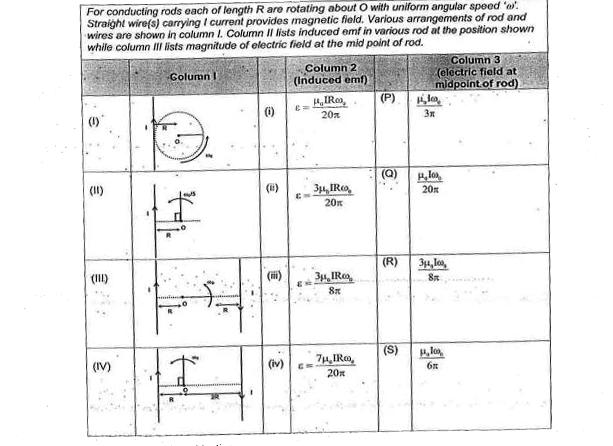 View Solution
View SolutionIn each question, there is a table having 3 columns and 4 rows. Based on the table, there are 3 questions. Each question has 4 options (a), (b), ( c) and (d), ONLY ONE of these four options is correct.
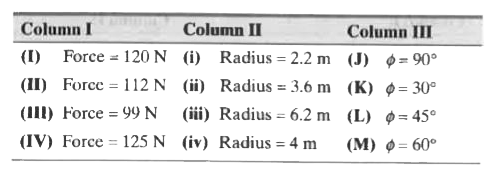
Which object has 137.5N⋅m as the resulting torque (as a vector)?View Solution
Knowledge Check
- Question 1 - Select One
In each question, there is a table having 3 columns and 4 rows. Based on the table, there are 3 questions. Each question has 4 options (a), (b), (c) and (d), ONLY ONE of these four options is correct.
In the given table Column I lists the elements in the circuit, Column II shows their combination and Column III shows the circuit diagram.

What are the conditions for L=L1+L2?A(I) (ii) (J)B(IV) (ii) (M)C(II) (i) (M)D(I) (iii) (J) - Question 2 - Select One
In each question, there is a table having 3 columns and 4 rows. Based on the table, there are 3 questions. Each question has 4 options (a), (b), (c) and (d), ONLY ONE of these four options is correct.
In the given table Column I lists the elements in the circuit, Column II shows their combination and Column III shows the circuit diagram.
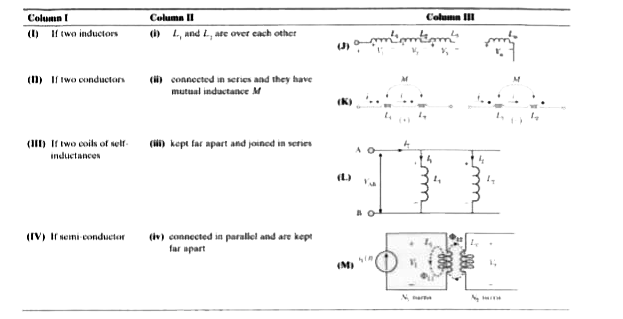
What are the conditions for M =K√L1L2?A(III) (i) (K)B(I) (i) (L)C(III (i) (M)D(II) (iii) (M) - Question 3 - Select One
In each question, there is a table having 3 columns and 4 rows. Based on the table, there are 3 questions. Each question has 4 options (a), (b), ( c) and (d), ONLY ONE of these four options is correct.

Which object has 480N⋅m as the resulting torque (as a vector)?A(I) (iv) (J)B(I) (i) (K)C(III) (iii) (L)D(I) (ii) (L)
In each question, there is a table having 3 columns and 4 rows. Based on the table, there are 3 questions. Each question has 4 options (a), (b), ( c ) and (d), ONLY ONE of these four options in correct.
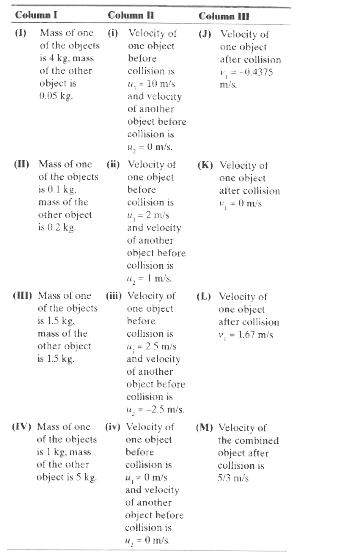
In which condition is the total momentum after collision 10 kg m/s ?View SolutionThe following tables has 3 columns and 4 rows. Based on each table, there are THREE questions. Each question has FOUR options (A), (B), (C), and (D). ONLY ONE of these four options is correct
Q
 View Solution
View SolutionThe following tables has 3 columns and 4 rows. Based on each table, there are THREE questions. Each question has FOUR options (A), (B), (C), and (D). ONLY ONE of these four options is correct
Q
 View Solution
View SolutionIn each question, there is a table having 3 columns and 4 rows. Based on the table, there are 3 questions. Each question has 4 options (a), (b), ( c) and (d), ONLY ONE of these four options is correct.
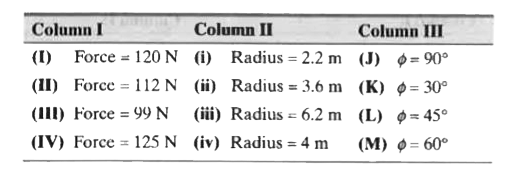
Which object has 178.2√3N⋅m as the resulting torque (as a vector)?View SolutionIn each question, there is a table having 3 columns and 4 rows. Based on the table, there are 3 questions. Each question has 4 options (a), (b), ( c ) and (d), ONLY ONE of these four options in correct.
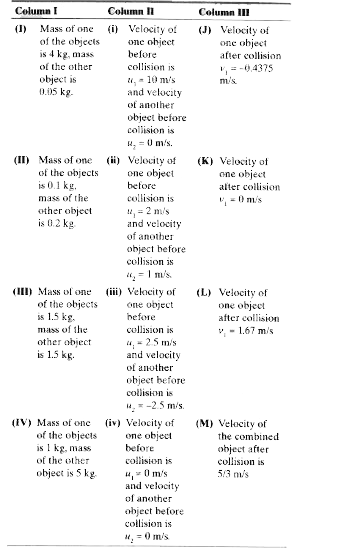
In which condition is the velocity of one of the objects after collision 1.165 m/s ?View Solution

